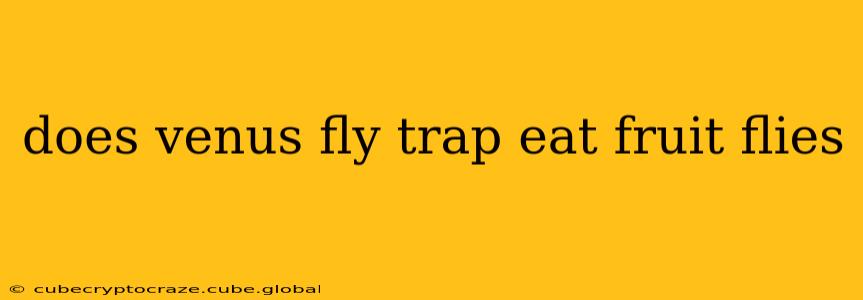The Venus flytrap ( Dionaea muscipula) is a fascinating plant known for its carnivorous nature. But what exactly does it eat? And are those pesky fruit flies on your counter a potential meal for this intriguing plant? Let's delve into the world of the Venus flytrap's diet to answer this question.
While the captivating snap of a Venus flytrap closing on its prey is often associated with larger insects, the truth is a bit more nuanced. The answer to whether a Venus flytrap eats fruit flies is: sometimes, but not reliably.
What Do Venus Flytraps Eat?
Venus flytraps are highly specialized plants adapted to nutrient-poor environments. They supplement their nutritional needs by trapping and digesting insects and other small invertebrates. Their preferred meals typically include:
- Flies: These are a common and readily available food source.
- Spiders: Small spiders often fall prey to the plant's ingenious trap.
- Ants: The trap's sensitive hairs trigger closure when disturbed by these crawling insects.
- Beetles: While larger beetles might be too big for a single trap, smaller ones are a perfect size.
Why Fruit Flies Might Not Be a Reliable Meal
Fruit flies, while technically insects, present some challenges for the Venus flytrap:
- Size: Fruit flies are relatively small and lightweight. Their movement might not trigger the trap's sensitive trigger hairs sufficiently to cause it to close. The plant needs to detect a substantial stimulus, often involving multiple triggers to ensure it's not expending energy on non-nutritious material like debris.
- Escape: Their small size and agility allow them to potentially escape the trap before it closes completely.
- Nutritional Value: While a fly does provide some nutrients, the relatively small size of a fruit fly means it may not offer enough sustenance to justify the energy expended by the plant in capturing and digesting it.
How to Feed Your Venus Flytrap Fruit Flies (If You Choose To)
If you're determined to try feeding your Venus flytrap fruit flies, here are a few things to consider:
- Larger Fruit Flies: Larger fruit flies, or multiple smaller ones clustered together, might provide a stronger trigger.
- Gentle Placement: Carefully place the fruit fly on the trigger hairs. Don't just drop it in; the plant needs to register the contact as a potential prey item.
- Limited Feeding: Overfeeding can damage the plant. A few carefully chosen fruit flies may suffice but are not necessary for its survival.
- Avoid Over-stimulation: Don't repeatedly try to trigger the trap with fruit flies, as this can exhaust the plant.
What Happens If a Venus Flytrap Catches a Fruit Fly?
If a fruit fly is successfully caught, the trap will close, and digestive enzymes will begin to break down the insect's soft tissues, extracting essential nutrients. After a few days, the trap will reopen, revealing the remaining chitinous exoskeleton.
Can I Use Fruit Flies As The Primary Food Source?
No. Fruit flies should never be the primary food source for a Venus flytrap. It's essential to provide a varied diet of appropriately sized insects (like flies, spiders, or ants) to ensure its health. Remember that feeding a Venus flytrap is not essential for its survival. The plant gets most of its nutrients from the soil, but insects provide additional nutrients.
Do Venus Flytraps Need To Eat Insects To Survive?
While they're carnivorous, Venus flytraps can survive without regularly consuming insects. They are photosynthetic, obtaining energy from sunlight like any other plant. However, supplementary insect feeding enhances growth and development.
By understanding the Venus flytrap's diet and its limitations, you can ensure the health and longevity of this fascinating plant. While fruit flies might be caught on occasion, they should not be considered a primary or reliable food source.
